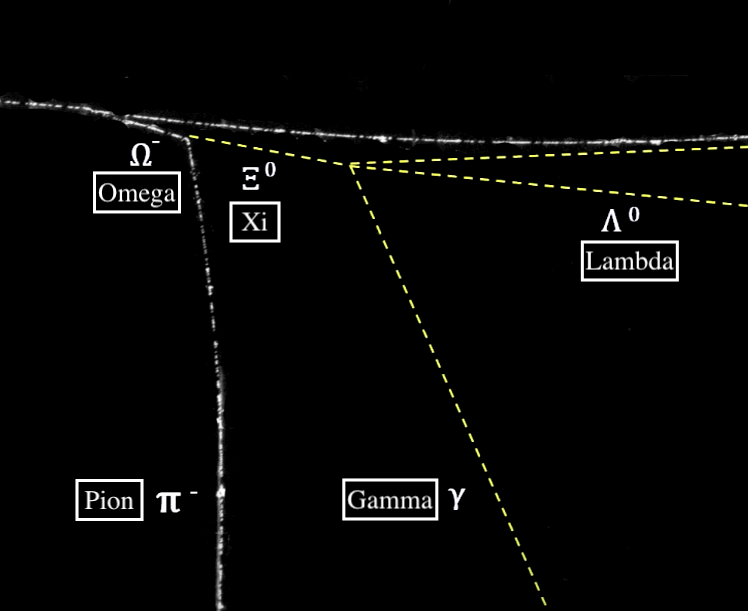Physics Lournal
Powered by 🌱Roam GardenThe Most Interesting Photo in Physics

This is is a photo showing the discovery of the Omega particle in 1964, predicted by Murray Gell-Mann 3 years earlier.
Here's that event, once you remove all the noise from the other particle events taking place in the photo.

So what's going on here?
Well, these various lines, are the paths that particles take, when traveling through a bubble chamber, a vessel filled with transparent liquid, as was standard for the time (typically superheated liquid hydrogen).
What makes this clever is that the application of a magnetic field to this chamber, allows for the identification of particles, based on their charges- electrons, for example, (negatively charged particles) will curve clockwise, where as photons, (positively charged particles) will curve counter clockwise.
In addition to charge, the curvature of a track is also related to momentum, in that, the higher the curvature of a track, the slower the particle must be moving, and once you relate momentum to energy, you can derive the mass of a particle!
Also, whenever we see two lines diverging from the same point, we know a particle decayed into a pair of particles.
So, moving from the right to left, we see a Positron, and electron pair, decaying from a Lambda particle.

The set of concentric circles in the upper right corner, are from a low energy positron, which we know decayed from a neutral Lambda particle (as well as a Positron, shown by the other slightly curved line originating from the same point as the electron).
The uppermost yellow dashed line corresponds to the paths of a Gamma ray, which result from the decay of a neutral "system", and are the highest energy states of Photons (Gamma rays being on the electromagnetic spectrum, and a type of light).
While it's beyond the scope of this breakdown, we know these Gamma rays create these particle pairs, because they carry enough energy to disturb particle fields, and it is these disturbances, that we perceive as particles.
The yellow dashed line on the bottom here, is the decay event of a neutral Lambda particle, which gave off a Pion, carrying away the negative charge, and a Proton, carrying off the positive charge.
We insert these dashed lines ourselves because neutral particles don't leave tracks. In short, they tend not to have strong magnetic fields, which are needed to transfer energy from particles to the substance their traveling in to create the bubbles that make the tracks.
So, we know that our Positron/Electron pair where spawned from Gamma rays, and our Pion/Proton pair were spawned from the decay of a Lambda particle, but we also know Gamma rays are emitted as a result of particle decay.
From this we know that the two Gamma rays and the Lambda particle were created in a decay event themselves.
Due to the conservation laws, we can add the masses and charges of these particles, and fit them to the description of a known particle: the neutral Xi particle.

Quick recap: we now know a Xi particle decayed, giving off Two gamma rays, which both spawned Electron/Positron pairs, and a Lambda particle, which decayed into a Pion/Proton pair.
If we take another step backward, we can observe the beginning of the Omega particle event: The Xi particle, was emitted, as well as a Pion, and it just so happens, that when you combine the particle properties of all of these, they fit Gell-Mann's prediction of the Omega particle properties!
